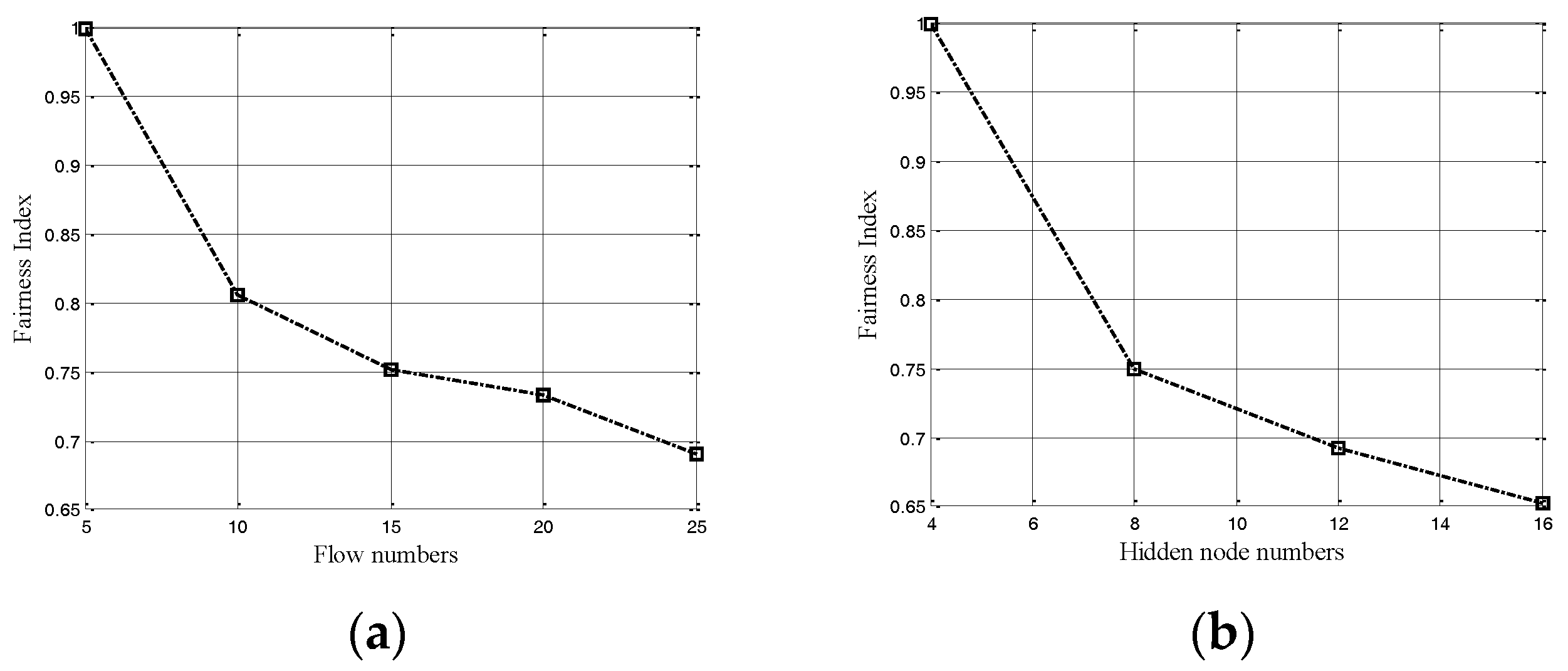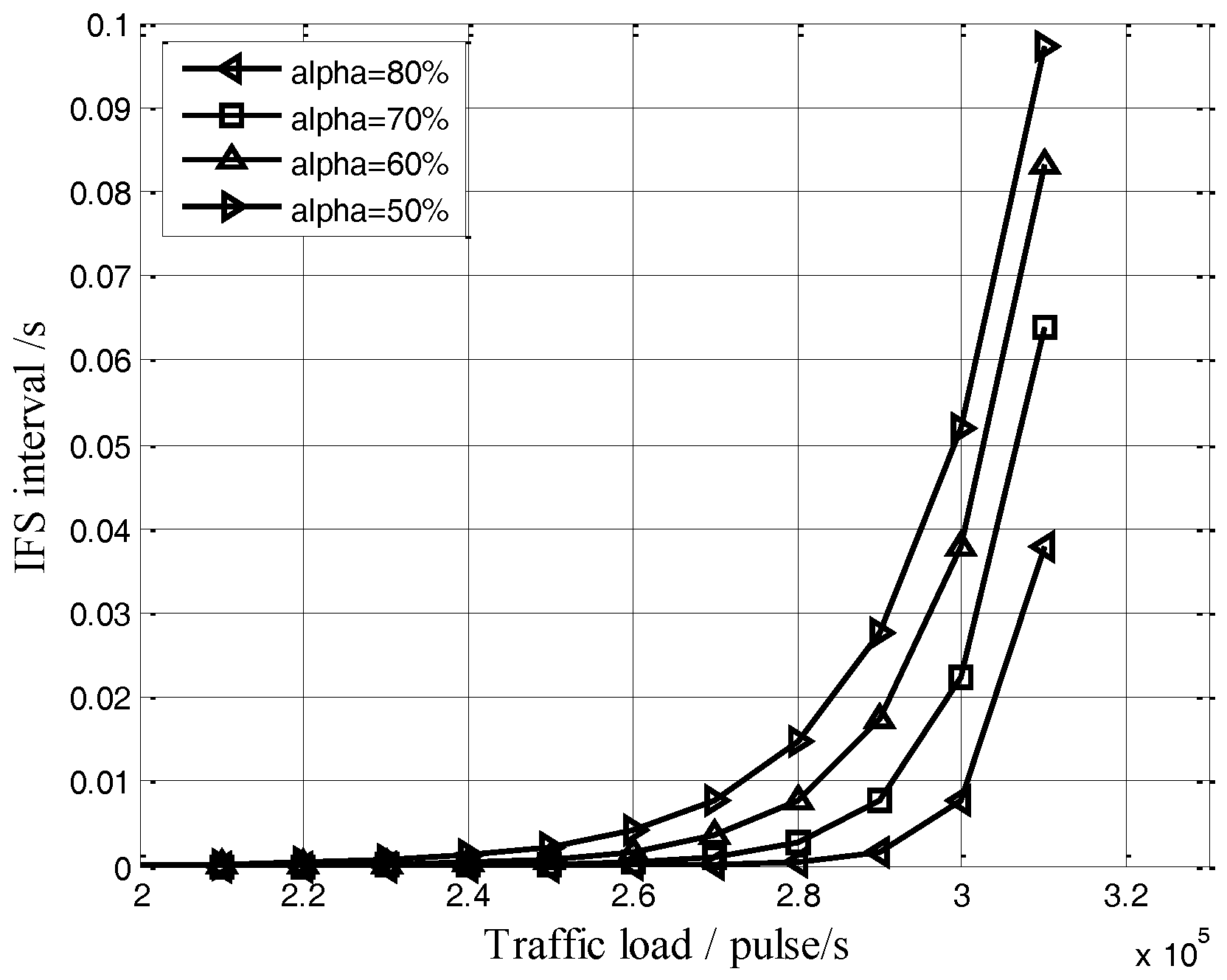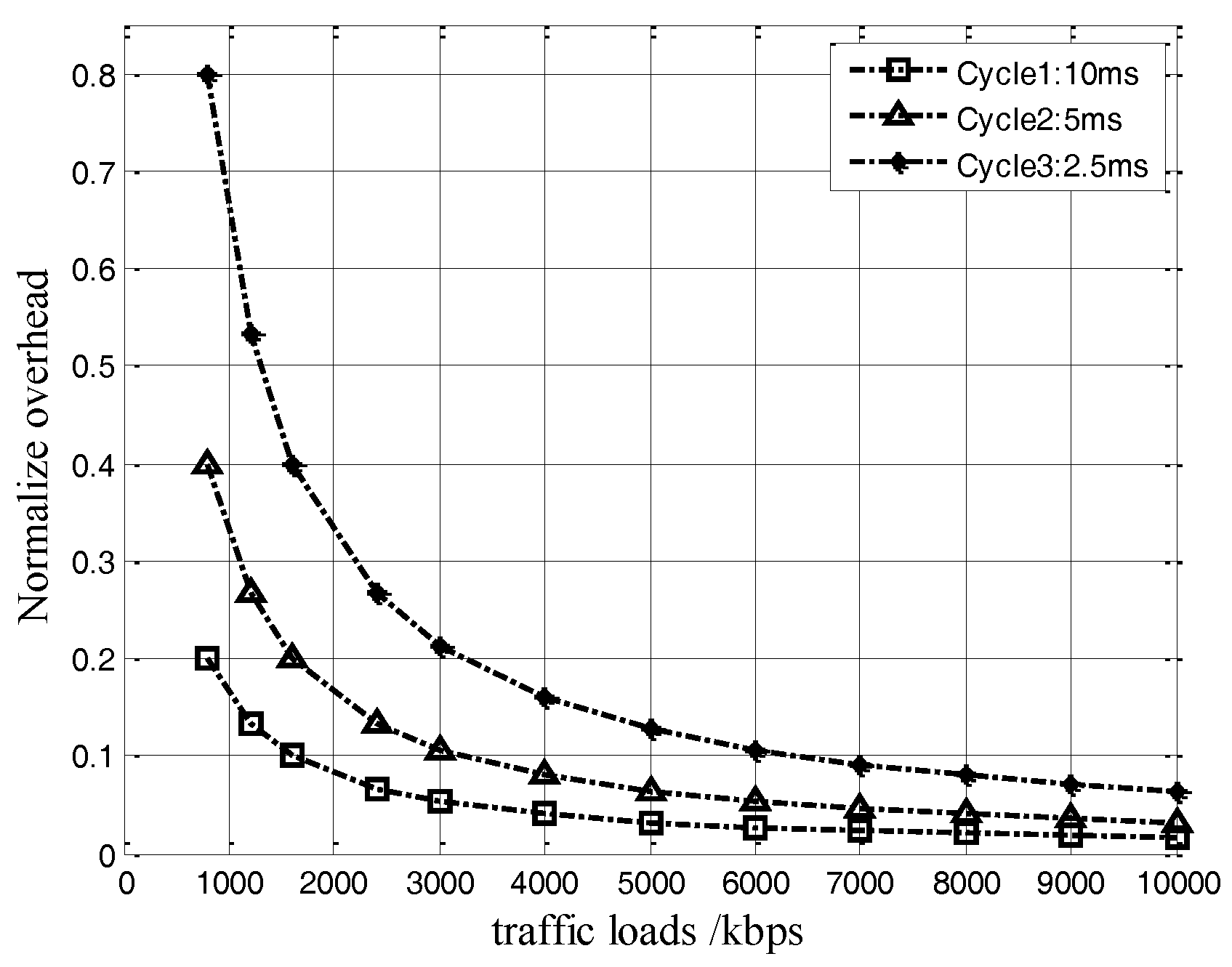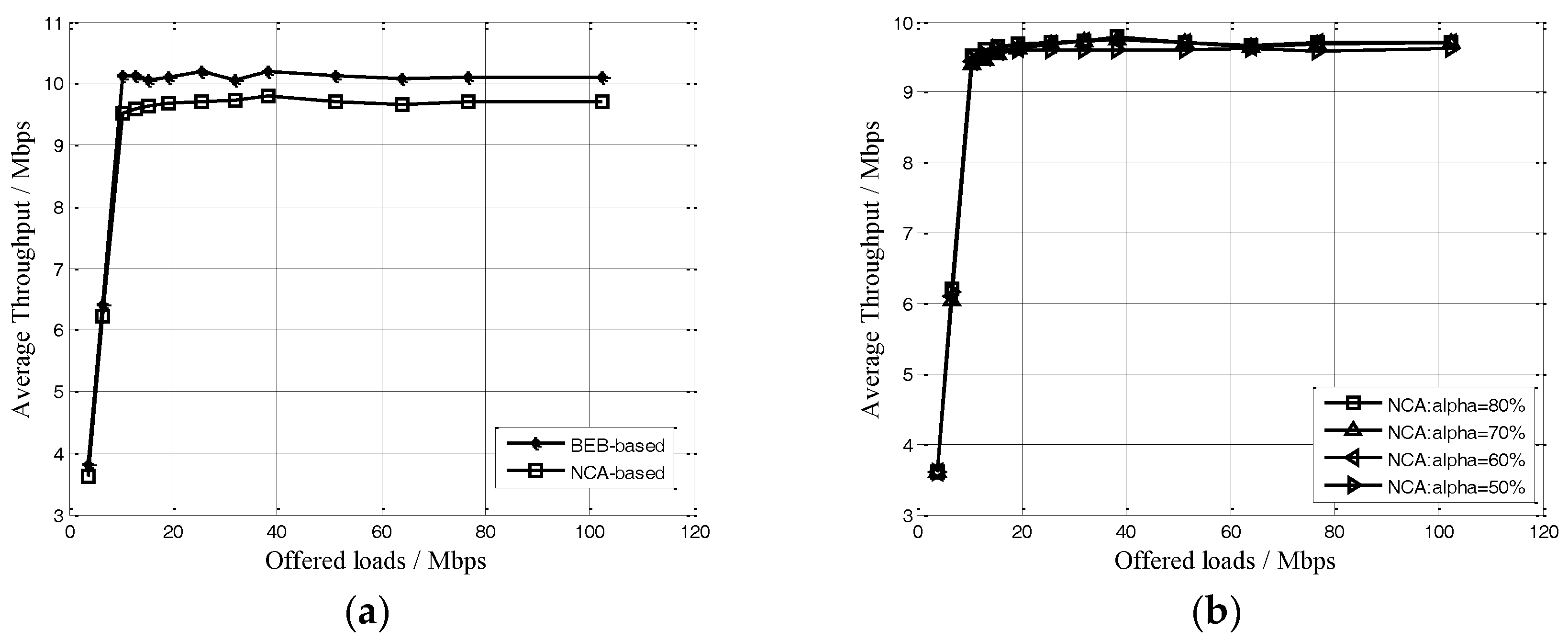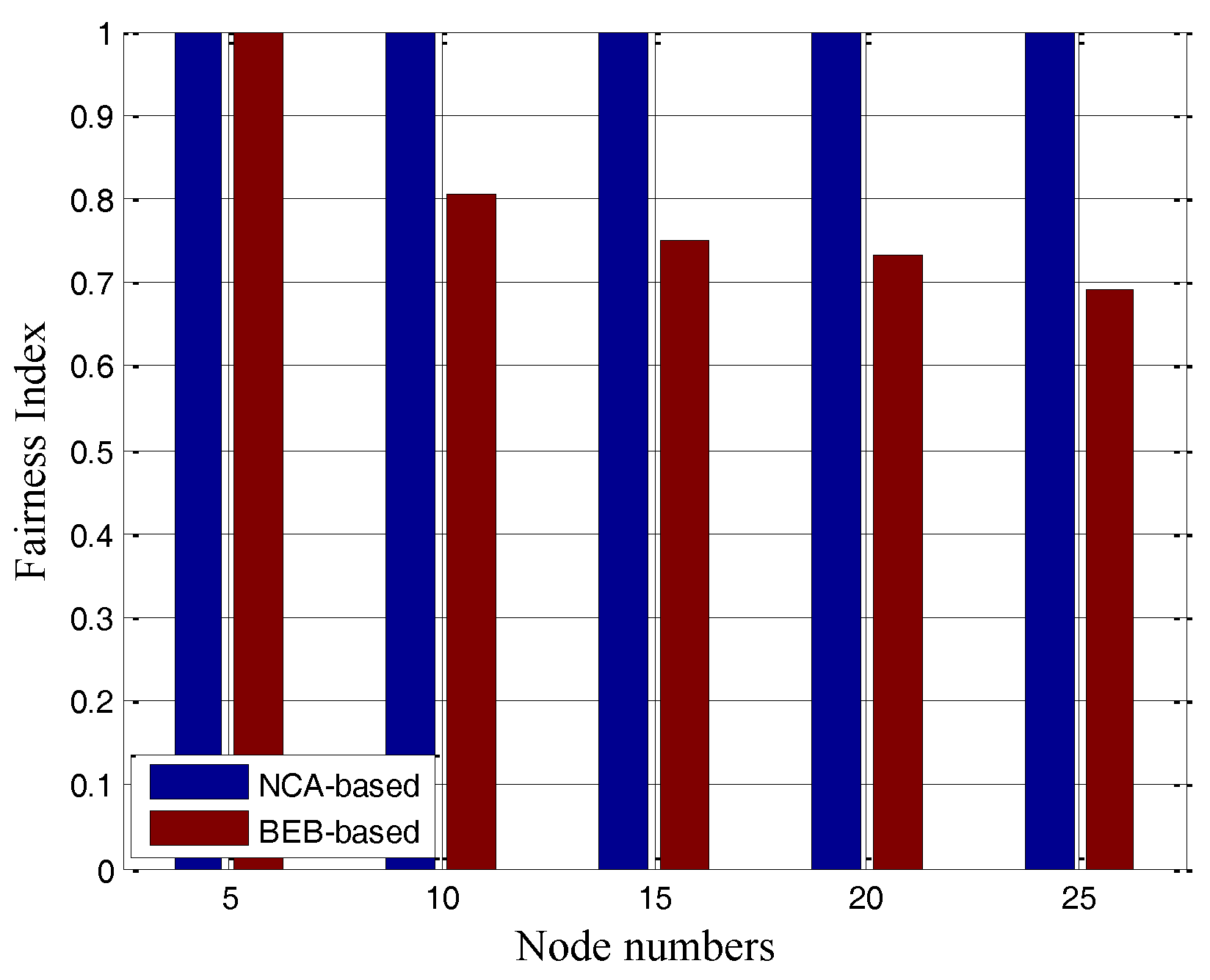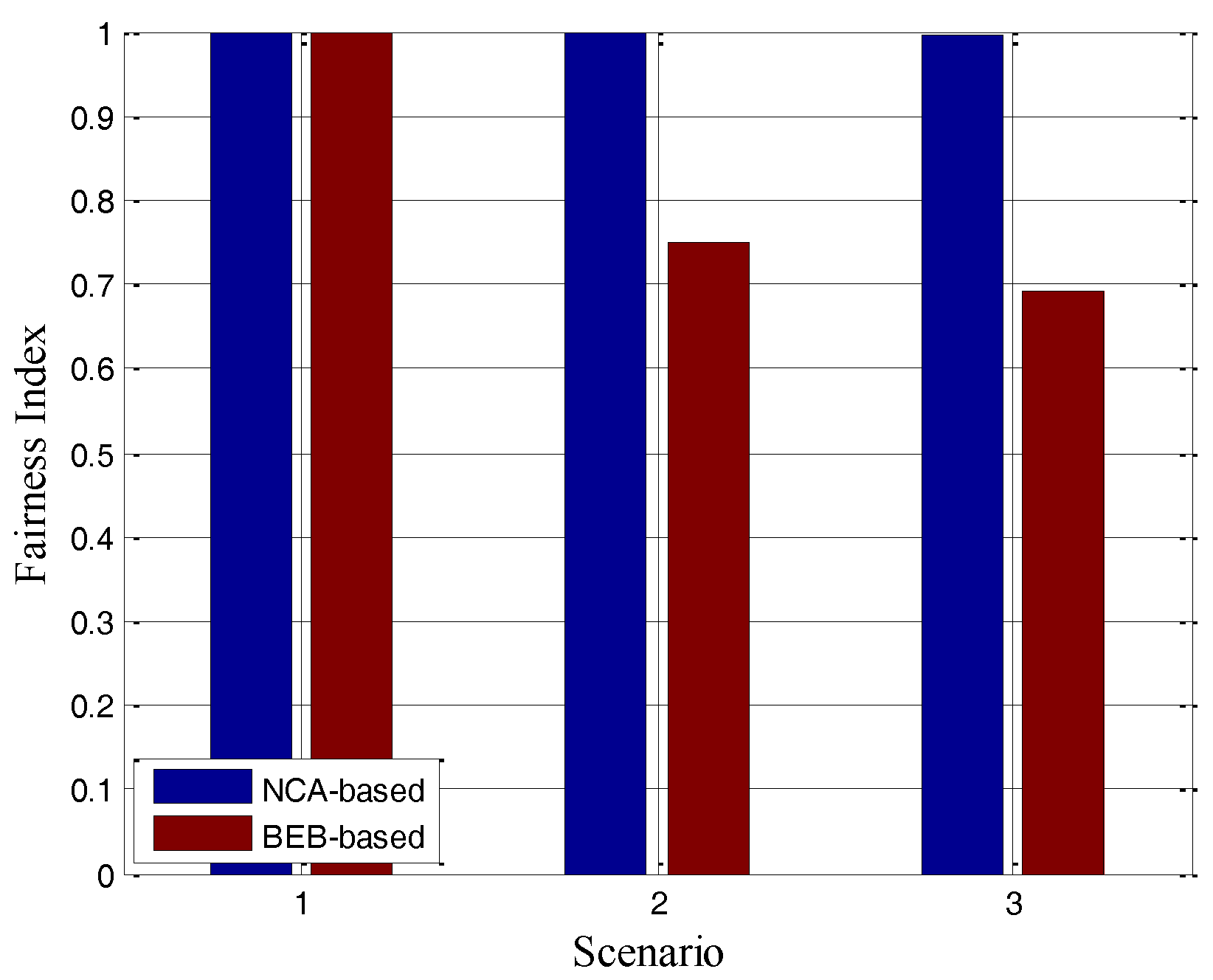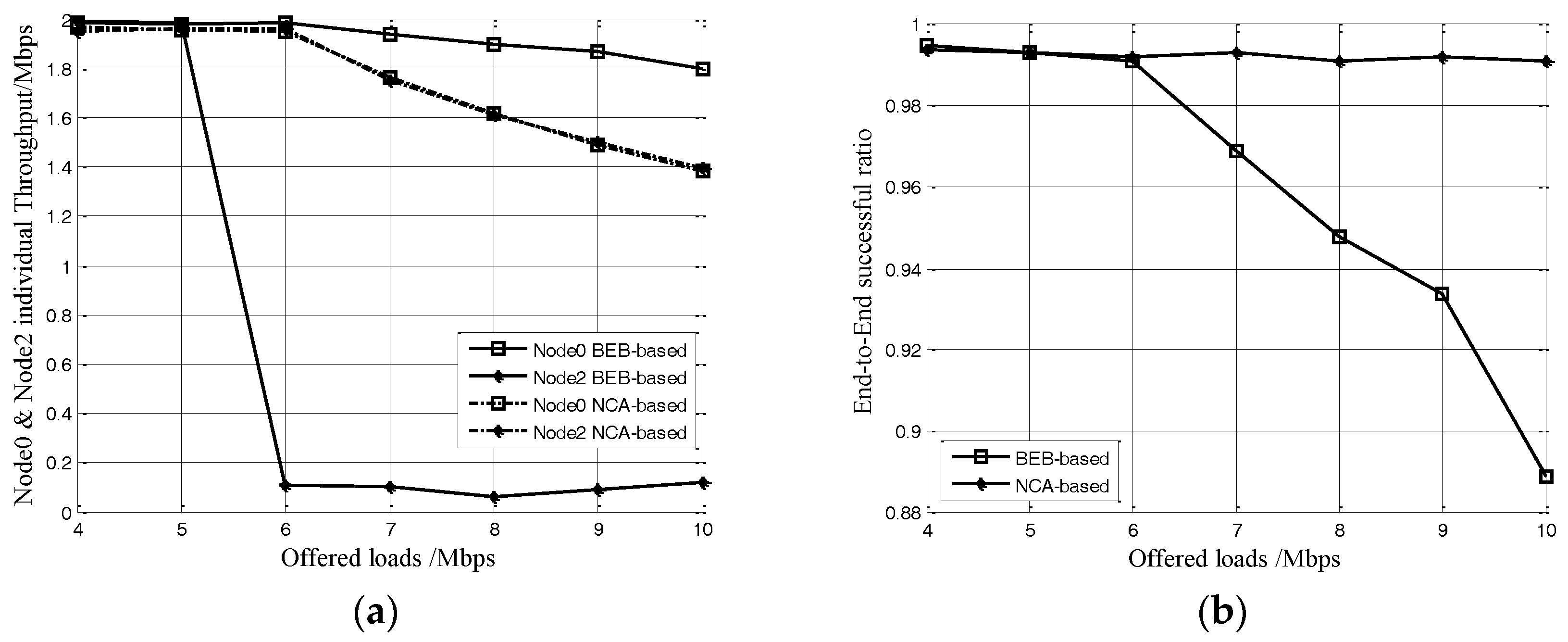1. Introduction
With the in depth research on wireless sensor network (WSN) applications, in recent years the application scene has gradually extended to the three-dimensional scene, and produced some new research areas, such as airborne sensor networks for air pollution monitoring [
1] or wildfire detection and monitoring [
2], underwater sensor networks for marine environment monitoring [
3] etc. In airborne sensor networks (ASNs), for several decades now information has been shared among manned and unmanned aircraft, as well as surface and ground platforms, to provide protected air-to-air and air-to-ground communications for civil services [
4]. Different from traditional WSNs, ASNs have several unique features, including large coverage areas, highly dynamic network topologies, unstable communication channels in the air, etc. One of the biggest challenges of designing ASNs is how to ensure a large number of geologically distributed nodes can simultaneously and efficiently access the shared communication channel with some notion of fairness among aircraft. With the fairness gradually becoming one of the important performance indicators for the network system, its related research has become a hot spot. In [
5], a token-based media access control (MAC) protocol as well as a time division multiple access-based (TDMA-based) protocol called Token-MAC for passive radio frequency identification (RFID) systems was proposed to solve the unfairness and low throughput of the current contention-based MAC protocols. Reference [
6] evaluated the performance of several secondary network (SN) coexistence schemes in terms of fairness among the coexisting SNs. The proposed coexistence scheme could achieve throughput and energy efficiency gains, while maintaining fairness among the coexisting SNs. In Reference [
7], the authors discussed the present uplink limitations due to the inherent fairness design of IEEE 802.11 distributed coordination function (DCF) by employing the carrier sense multiple access with collision avoidance (CSMA/CA) scheme with a binary exponential back-off (BEB) algorithm, and proposed the solution of offloading the uplink traffic using IP Flow Mobility (IFOM). The proposed uplink access scheme for IFOM combined weighted proportional fairness in the Wi-Fi access and price-based resource allocation in the long term evolution (LTE) upload, which improved the energy efficiency of the user equipments (UEs) and increased the offloaded data volume under the concurrent use of access technologies that IFOM allows.
Moreover, due to the strict demands of timeliness and reliability of the time-sensitive information, and the existence of propagation delay in ASNs, the MAC protocol for ASNs must be optimized to meet the requirements of low latency and the end-to-end success ratio of the time-sensitive information. In previous studies on MAC protocols for WSNs, there were two categories: the scheduled MAC protocols and the random access protocols. In the scheduled MAC protocols, a node is explicitly assigned transmission time slots to ensure its Quality of Service (QoS), which can precisely control active nodes or links for transmission at any time by scheduling information [
8,
9]. Therefore, with the scheduled MAC each active link can obtain higher throughput. On the contrary, in the random access protocols, the WSNs can enable lower latency operations with less node coordination [
10]. However, due to the lack of precise coordination, the random access MAC suffers from excessive collisions, and accordingly a kind of adaptive random access MAC protocols for traffic loads in ASNs is proposed [
11,
12,
13,
14]. The basic idea of adaptive random access MAC is to collect traffic loads in channel and wait for a random time by employing the binary exponential back-off (BEB) algorithm at high traffic loads, which helps to reduce the traffic load and minimize collisions while maintaining system stability. The BEB algorithm always favors the latest successful nodes, while keeping for other nodes under starvation, which obviously results in the short-term unfairness of the MAC [
15]. Furthermore, the hidden nodes would aggravate the above unfairness [
15,
16]. Specially, in [
14] a receiver-based time constraint model is built to help calculate precise network loadings to adaptively adjust the access threshold, but the fairness among all nodes cannot be guaranteed. In order to improve fairness among all nodes, the size of contention window of MAC layer is adjusted by collision statistics [
17,
18,
19,
20,
21] or handshake mechanisms [
22,
23,
24,
25]. Specifically, by accurately adjusting the inter-frame space (IFS) interval in the MAC layer, a better fairness performance could be achieved [
21]. Unfortunately, due to the significantly increased propagation delay caused by retransmissions under collisions, the above modified MAC cannot be directly applied in ASNs.
In this paper, a neighbor-channel-aware (NCA) MAC for ASNs is proposed to improve the MAC fairness with low overhead. The highlights of the proposed protocol lie in two aspects. Firstly, by adding NCA frame and exchanging NCA between neighbor nodes periodically, all nodes could receive their neighbors’ actual channel load information (CLI). Simultaneously, the problem of the inaccurate traffic load caused by the hidden nodes also can be solved. Secondly, a novel back-off algorithm facilitates the neighbor nodes to cooperatively adjust the MAC layer IFS interval based on the traffic load. Thus the unfairness problem caused by the BEB algorithm and the hidden nodes is tentatively resolved. Furthermore, by avoiding network overloading, the end-to-end success ratio of the packets transmission among active nodes can be sufficiently improved, with decreased delays in the process of the retransmission. In our proposal, the added NCA frames and exchanging operations show an asymptotically decreasing property under a normalized protocol overhead, which is quite different from the collision statistics and handshake which are effective.
In the following parts of this paper, the network model and the unfairness problem in ASNs will be firstly presented in
Section 2, based on which a new MAC protocol will be proposed in detail in
Section 3. Then comes the simulation results in
Section 4. Finally, conclusions are given in the last section.
3. The Proposed MAC Protocol
In general, all nodes in WLAN use control frames by handshake mechanism to relieve the hidden nodes problem. Based on this idea, we add a neighbor-channel-aware (NCA) frame in the MAC layer (which belongs to the small number of low-latency packets and could be transmitted directly) to realize information sharing between the neighbor nodes, which could relieve the inaccurateness of the traffic loads caused by the hidden nodes. Different from the handshake mechanism in WLANs based on data driven, the NCA frame in our proposal will be sent periodically. In this section, the NCA-based MAC protocol is firstly presented in detail. As mentioned before, the unfairness frequently happens in overload avoidance process, so we are going to explain how to ensure the networks overload avoidance by using the NCA frame in the following subsection.
3.1 Networks Overload Avoidance
The NCA-based MAC frame contains the node ID and its local channel traffic loads information (CLI). The CLI is defined as the number of bursts which received by the nodes from the frequency hopping channel in a cycle. The whole NCA frame structure is shown in
Figure 4, for instance, occupying 4 bytes in this paper.
The neighbor nodes exchange the NCA frames with each other periodically. When a node receives the NCA frames from its neighbor nodes, it will read the
CLI of the NCA frames and reset its
CLI which is equal to the maximum value of the
CLIs (its own
CLI and its neighbor’s
CLI) to avoid the inaccurate
CLI caused by the hidden nodes problem. When the node’s local
CLI is higher than the
Max_NL (i.e., the access threshold), it would launch the BEB back-off mechanism to avoid networks overload. However, the randomness would still lead to the unfairness of the obtained channel resources. In this paper, we further define
A_Threshold as a new access threshold:
in which
is defined as the percentage of the
Max_NL.
The MAC protocol in ASNs used Max_NL as the only criterion for back-off, resulting in the unfairness of the random BEB algorithm. We introduce A_Threshold, with the aim of allowing the back-off time dynamically varying with the network loads among the interval [A_Threshold, Max_NL]. In such a case, the unfairness of the BEB algorithm can be meliorated by adjusting the value of α.
Each node checks if the CLI exceeds the new access threshold before the transmission. If the CLI exceeds the A_Threshold, which means that there would potentially be overload condition, then the node would have to enable the back-off algorithm to increase the IFS interval as shown in the following sub-section.
3.2 The Back-off Algorithm
The proposed back-off algorithm can be described as follows:
The node collects the traffic loads and compares the CLI to the A_Threshold before transmission.
Case I: If CLI < A_Threshold, the node would not use a back-off algorithm.
Case II: If CLI > A_Threshold, the node would use a back-off algorithm by counting an accurate IFS interval. The transmission of the frame would not begin until the back-off counter equals zero.
Next, we define some parameters as follows:
R is defined as the average number of bursts per second sent by the nodes.
Rmin is defined as the minimum of R, and Rmax was defined as the maximum of R.
is defined as the exponential decrease of the R, and R changes in the rang [Rmin, Rmax] with the CLI changing in the rang [A_Threshold, Max_NL],
So,
can be given by:
and:
Thus R would decrease with the increase of CLI, which means the interval for sending two consecutive packets would increase.
is defined as the interval for sending two consecutive packets (also be known as the IFS interval), given by:
is defined as the transmission time of a frame, which is:
is defined as the length of the frame in bits, and is defined as the transmit rate (bit/s), so by controlling the , node could control the average number of transmission bursts per second.
Figure 5 shows the exponential increase of the IFS interval along with the traffic load increase, under the back-off parameters shown in
Table 1. The IFS interval (the time of waiting to access channel) would be longer with the larger value of
α in the same traffic loads condition.
The nodes will access the frequency-hopping channels distributively by the above real-time back-off algorithm, thereby avoiding the short-time unfairness of the BEB algorithm caused by the randomness.
3.3. Analysis of NCA’s Overhead and Fairness
3.3.1 Protocol Overhead Analysis
In our proposal, the use of NCA frames obviously indicates extra overhead increases in the original MAC protocol. Since the NCA frame is only periodically sent among neighbor nodes, the overhead size can be decided by the node number and the periodic time (cycle) of the NCA frame, but without relation to the traffic load. In theory, the protocol overhead is proportional to the node number and the periodic time of the NCA frame, i.e.,
. The functional relationship between the normalized protocol overhead (overhead/traffic load) and the traffic load can be shown in
Figure 6 by numerical results.
In
Figure 6, it can be seen that, under the same traffic load conditions, the greater the cycle, the less normalized overhead. When the traffic load increases, the corresponding normalized overhead decreases. Take the 10 ms cycle as an example, as the traffic load is increased to 2 Mbps, the normalized protocol overhead will be reduced less than 9%, which would even drop further along with the increase of traffic load. Therefore, we can conclude that, by the NCA-based MAC, the protocol overhead shows asymptotically decreasing property in ASNs.
3.3.2. Fairness Analysis
We can also analyze the fairness provided by the NCA-based MAC here. Define the channel utilization of the nodes as
, where
is the actual sending time. According to the NCA frame for the accurate channel traffic load information, the node will calculate the precise IFS by
. By the calculation process in
Section 3.2, each node could obtain the same
in the same traffic load. When the frames are in the same length, the channel utilization of each node is equal, which means that the fairness of the protocol enables using shared media resources among all the nodes uniformly.
4. Simulations
In this section, we are going to present the simulation experiments by using opnet14.5 network simulation software in which the seed parameter in each simulation scenario is set to 1000 (that is, the number of samples is 1000), and we compare the protocol performance of the NCA-based and the traditional BEB-based MAC schemes. The receiving range of the nodes is set as its transmission range. The physical parameter is based on those of the frequency-hopping channel simulations in [
14] throughout this section, which are shown in
Table 2. The NCA-based back-off parameters are set as
Table 1 in
Section 3. The cycle time is set as 10 ms. The BEB algorithm parameters refer to the IEEE 802.11 DCF [
19,
20]. The CW
min is chosen as 15 and it has been retried for 5 times.
Before discussing the fairness performance of the protocol, we present the simulation experiments to compare the average throughput of NCA-based with different value of α and BEB-based MAC schemes. In this simulation scenario, nodes are randomly distributed in a 150 km × 150 km plane area and the number of nodes is 100. The NCA frame’s cycle equals to 10 ms, so the protocol overhead could be calculated, which equals to 0.32 Mbps.
Figure 7 shows the average throughput of the NCA-based with different value of
α and BEB-based MAC schemes.
In
Figure 7a, the average throughput of the NCA-based MAC with the
α = 80% is lower than that of the BEB-based due to the protocol overhead. Nevertheless, the difference approximately equals to the corresponding overhead, which is far less than the maximum channel loads of the system. In
Figure 7b, the different of the average throughput of NCA-based with different value of α is very small, so the value of
α would not affect throughput performance, especially in networks overload conditions. In following simulation experiments, the value of
α is set as 80%. We still use the FI as (1) given in
Section 2.2. The indicators of measuring the performance of the protocol include the FI, the average throughput and the end-to-end success ratio. To be specific, the end-to-end success ratio is defined as the total number of transmitted packets divided by the number of successfully received packets, which is one of the most important indexes in ASNs. Then we check the MAC performance under different topologies, including fully-connected topology, hidden nodes topology and string topology shown in
Figure 1.
4.1. Fully-Connected Topology
In the dashed circle shown in
Figure 1a, nodes are in the transmission range of each other. Five individual experiments with different numbers of nodes were carried out. In the simulation scenario, nodes are randomly distributed in a 150 km × 150 km plane area. For each node, the Poisson traffic is adopted and the mean rate could achieve the maximum value (2 Mbps). The unfairness occurs only when there are more than five transmissions in process simultaneously, in which the maximum networks load is 10 Mbps. The results of average aggregated throughput and end-to-end success ratio are given in
Table 3, and the FIs under different MAC protocols are shown in
Figure 8.
In
Figure 8, the BEB-based MAC protocol results in serious unfairness problem in all cases except the first one as the channel is not filled up (i.e., when the node number is 5, all the nodes can access channels with sufficient fairness by both the BEB-based and NCA-based protocols). This is consistent with our previous analysis. In all cases of different node numbers, the FI of NCA-based MAC protocol can always approach 1 with tiny gaps, which means that most nodes in the network can share the channel resources and chances to access for successful transmissions. It makes all nodes share the wireless channel with enough fairness and stability. From
Table 3, by the BEB-based and NCA-based protocols, the end-to-end success ratios can both reach up to 99%. We can also notice that the average throughput of the NCA-based MAC is a little lower than that of the BEB-based, but is still close to the maximum networks loads (10 Mbps in theory), which tells us the NCA-based MAC can guarantee the system throughput close to the ideal level.
4.2. Hidden Nodes Topology
We then check the performance under the hidden nodes topology as shown in
Figure 1b. We set different number of nodes to generate different offered loads in the two dashed circles. For each node, the Poisson traffic is adopted and the value of its mean rate is high enough to achieve maximum rate (2 Mbps). The experiment parameters are shown in
Table 4 (node amount (left) includes node 0 and node amount (right) includes node 1). Scenario 1 shows that the channel of node 0 and node 2 are both in a low traffic loads condition. Scenario 2 shows that the channel of node 0 is in a low traffic loads condition while the channel of node 2 is in a high traffic loads condition. And scenario 3 shows that both of them are in a high traffic loads condition.
The simulation results are given in
Table 5 and
Figure 9. The BEB-based MAC protocol results in a serious unfairness problem and an obvious decrease of the end-to-end success ratio in scenario 2 and scenario 3. Due to the unequal traffic loads in channels, node 0 will get much higher throughput than node 1. In the contrary, the FI of NCA-based MAC protocol is close to 1 in scenarios 2 and 3, indicating that nodes would get a better share of the channel resources and more chances to access the channel to transmit even though they are hidden from each other. It makes nodes share the multi-hop wireless channels fairly and stably by receiving NCA frames and adjusting the back-off time accurately.
4.3. String Topology
Finally, we present the experiments of evaluation performance of the NCA-based and BEB-based schemes under the string topology, as shown in
Figure 1c. In this case, one node is set in left dashed circle, and it generates Poisson traffic with the same mean rate as node 0 and 2 of 2 Mbps. Five nodes are set in the right dashed circle, which generate Poisson traffic at the same mean rate.
Figure 10 shows that the BEB-based scheme will cause a serious starvation problem for node 1 and an obvious decrease of the end-to-end success ratio when the loads offered by the five nodes in the right dashed circle reach 6 Mbps. These results are consistent with the following facts: when all nodes in the two dashed circles are node-1’s neighbor nodes, node 1 has to content with the other nodes for channel resources. As the neighbor nodes are hidden from each other, they could transmit without back-off due to the lower loads in each dashed circle, thus their transmission could fill up the node 1’s channel as the loads offered by the five nodes in the right dashed circle increase to 6 Mbps (meanwhile, the traffic load in the channel of node 1 reaches 10 Mbps). This causes node 1 to always be in the back-off phase to avoid its local channel from overloading. On the contrary, in our NCA-based scheme, if nodes in two dashed circles receive the NCA frame transmitted from node 1, its CLI will indicates its neighbor nodes with a higher proportion of channel share than what they should obtain. Its neighbor nodes would increase their back-off time accordingly. Along with the increase of nodes’ inaccurate back-off time, the node 0’s throughput can be balanced with the neighbor nodes, showing better fairness than the BEB-based one. At the same time, the end-to-end success ratio in node 1 could be maintained above 99% even under the condition of high offered loads as
Figure 9b shows.


